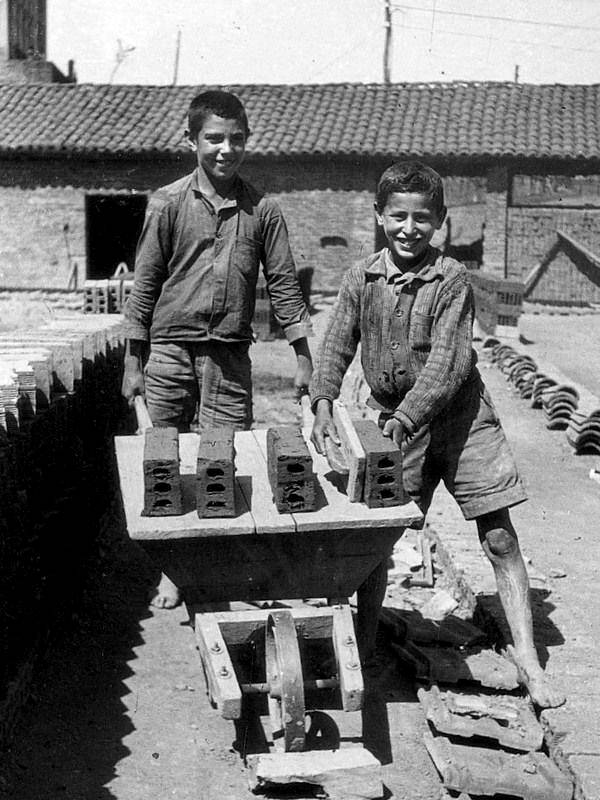
Spain/España: Child Labor/Labor Infantil

Figure 1.--These boys are working for a brick works located in Asturias during 1945. Asturias is situated in northwestern Spain along the Bay of Biscay coast. It is part of the moutaneous area that the Moors had difficulty conquering and small Christian coomunities were able to hold out (8th century). At the time, child labor was still very common and school only compulsory through the 3rd grade. These boys look to be about 10-12 years of age. The Spanish Government passed a new law in 1945 requiring school attendance through age 12 years.
|
|
Many Spanish boys worked until after World War II. Spain was a largely agricultural country with a large peasant population. Spain is a good example of the mind-bending ignorance prevalent concerning economic trends. Many people associate the industrial revolution and capitalism with poverty and child labor. Do an internet search on child labor and see how many sites begin the discussiion historically with the idustrial revolution. In relity it is the countries (like Spain) that did not participate meaningfully in the industrial revolution where chil labor was indemic. And it was the rich ndustrial countries (here Britain was a laggard) that create public school systems for children rather than having them work from an early age. Spain passed a law organizing the primary school system in Spain (1857). Attendance was made compulsory from 6 to 9 years of age. In 1939 a new law stated that the attendance would have been compulsory untill 12 years of age, but this rage limit was not enforced everywhere. Enforcement was especially lax in poor communities and rural areas. It was fairly common to see school-age boys working in Spain. The boys here in 1945 are a good example (figure 1). Large numbers of Spanish boys were involved in agricultural work. Girls were less likely to work, except as childhood servants. It is difficult to assess why Spain did not make greater progress against child labor. Left-wing authors will question the morality of conservative groups. Amother facor is that Spain was a poor, largely agricultural country with limited resources available to expand the education system. The efforts of workers to obtain basic rights was a major cause of the Civil War. Left-wing groups pushed for major reforms. Many were hostile to capitalism and property rights. The country's conservative Church, industrialists, and landowners were unwilling to concede, in part because of the fear of Communism and the terror directed against the church and properrty rights in the Soviet Union. The peasantry still highly incluenced by the Church were not as enthusiastic about radical reform as the the urban work force. Only after World War II did Spain pass a law that reorganized the Spanish primary school (1945). Attendance was made compulsory for children 6 to 12 years of age. And this time eforcement was more strict. [Galvez]
Sources
Gálvez, Inmaculada Egido. "La evolución de la enseñanza primaria en España: organización de la etapa y programa de estudio," Tendencias Pedagógicas (1995), pp. 75-86.
HBC

Navigate the HBC Site Spanish Pages:
[Spanish art]
[Spanish choirs]
[Spanish movies]
[Spanish royalty]
[Spanish regions]
[Spanish youth organizations]
Navigate the Boys' Historical Clothing Web Site:
[Return to the Main country sports page]
[Return to the Main Spanish activity page]
[Return to the Main country child labor page]
[Introduction]
[Activities]
[Biographies]
[Chronology]
[Clothing styles]
[Countries]
[Bibliographies]
[Contributions]
[FAQs]
[Spanish glossaries]
[Images]
[Links]
[Registration]
[Tools]
[Boys' Clothing Home]
Navigate the Boys' Historical Clothing national pages:
[Return to the Main Spanish page]
[Return to the Main countries page]
[Australia]
[Belgium]
[England]
[France]
[Germany]
[Ireland]
[Italy]
[Japan]
[Korea]
[Mexico]
[Scotland]
[United States]
Created: 6:36 PM 5/21/2013
Last updated: 6:36 PM 5/21/2013



